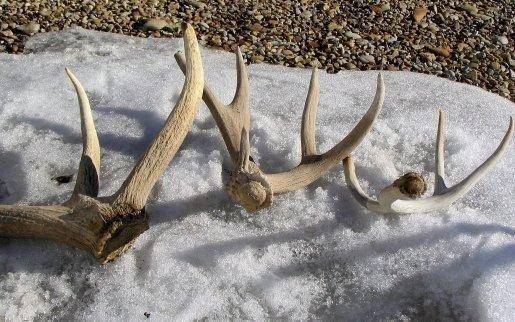The warmer weather is bringing more and more people into Utah’s backcountry. But many of these folks aren’t hiking or mountain biking– they’re “hunting” for shed antlers.
Every spring, shed antler hunters comb Utah’s backcountry, looking for antlers that have dropped from the heads of deer, elk or moose.
These animals shed their antlers every winter as part of their life cycle. Finding their antlers is a fun way to beat “cabin fever” and enjoy Utah’s backcountry in the spring.
If you decide to look for shed antlers this spring, remember to look for them only on foot. Keep your off-highway vehicle and truck only on roads and trails that are open to their use.
If you take your OHV or truck off of legal roads and trails, you can do serious damage to the habitat that deer, elk and other wildlife rely on.
Because the ground is muddy in the spring, it’s easy for vehicles to leave deep tracks this time of the year. Those tracks erode the soil. And that erosion reduces the ability the land has to support deer, elk and other wildlife.
The scars that are left also take years to heal. The tracks are an eyesore that causes people to further oppose OHV use and shed antler hunting.
If you’ll follow some simple rules provided by the Division of Wildlife Resources, you can have fun collecting shed antlers without damaging the landscape and causing animals stress:
- Once you arrive at your shed antler hunting area, park your vehicle and hunt for shed antlers on foot.
- Once you’ve found some antlers, pack them to the nearest road. Then leave them near the side of the road until you can drive back to pick them up.
- Please leave the area as good as you found it. Don’t be responsible for more land closures and vehicle restrictions in Utah.
As you’re collecting antlers, please remember that you may not collect antlers that are still attached to the skull.
This restriction was enacted after DWR conservation officers discovered people were shooting trophy animals on their winter range. In the spring, they’d return and retrieve the heads and antlers of the animals they had poached.
If officers stopped and questioned them, they would simply say that the animal the head and antlers belonged to must have died of natural causes, and they were lucky to find its antlers.
Telling a shed antler from an antler that’s still attached to a skull plate or that’s been broken off of a skull plate is easy:
- Shed antlers — which are legal to possess — have a rounded base, commonly called a button or burr.
- Antlers that are attached to a skull plate or that have been broken off of a skull plate do not have this button or burr.В And you may not possess them legally.
If you want to gather shed antlers in Utah between now and April 15, you must complete a free shed antler gathering course first.
If you wait until April 15 or later to gather antlers, you don’t need to complete the course.
The free course is available at www.wildlife.utah.gov/shedantler.
After you finish the course, make sure you print a certificate that shows you’ve completed the course. “And make sure you carry your certificate with you,” says Mike Fowlks, Law Enforcement Section chief for the DWR. “By law, you must have your certificate with you while you’re gathering shed antlers.”
If you have young children, and you’ve completed the course, your children don’t need to complete it. As long as you’ve completed the course, your certificate will cover your kids too.
Fowlks says if you complete the course, you can gather antlers across Utah. “Please remember, though, that many of the state’s wildlife management areas are closed in the spring to protect wildlife,” he says.
For more information, call the nearest Division of Wildlife Resources office or the DWR’s Salt Lake City office at 801-538-4700.

